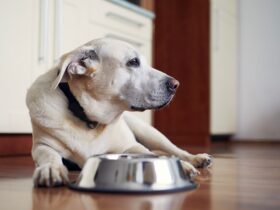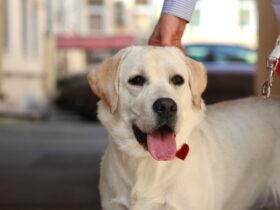Incontinence is a common issue among senior dogs and can significantly impact their quality of life. As dogs age, they may experience difficulty controlling their bladder or bowels, leading to accidents and discomfort. Addressing incontinence involves understanding its causes, implementing effective management strategies, and making necessary home adjustments to ensure your senior dog remains comfortable and happy. This comprehensive guide offers detailed insights into helping your senior dog with incontinence troubles.
Understanding Canine Incontinence
What is Incontinence? Incontinence in dogs refers to the inability to control the bladder or bowels, resulting in unintended urination or defecation. It can be caused by a variety of factors, including aging, medical conditions, or hormonal imbalances.
Types of Incontinence
- Urinary Incontinence: Involves involuntary urination, often seen as leaking or dribbling of urine.
- Fecal Incontinence: Refers to the inability to control bowel movements, leading to unintentional defecation.
Causes of Incontinence in Senior Dogs
Understanding the underlying cause of incontinence is crucial for effective management. Common causes include:
- Hormonal Changes
- Spay/Neuter Effects: Hormonal changes after spaying or neutering can lead to urinary incontinence, especially in female dogs.
- Age-Related Changes
- Muscle Weakness: Aging can weaken the muscles responsible for bladder control, leading to leaks.
- Medical Conditions
- Urinary Tract Infections (UTIs): Infections can cause frequent urination and loss of control.
- Kidney Disease: Impaired kidney function can lead to increased urine production and incontinence.
- Diabetes: Diabetes can cause excessive thirst and urination, contributing to incontinence.
- Neurological Disorders
- Spinal Issues: Conditions affecting the spinal cord or nerves can interfere with the signals controlling bladder and bowel function.
- Prostate Problems
- Enlarged Prostate: In male dogs, an enlarged prostate can pressure the bladder and cause incontinence.
Diagnosing Incontinence
A proper diagnosis is essential for addressing incontinence effectively. The diagnostic process typically involves:
- Veterinary Examination
- Physical Exam: Your vet will conduct a thorough physical examination to assess your dog’s overall health and identify any signs of underlying issues.
- Urinalysis and Blood Tests
- Testing: Urinalysis can help identify infections, while blood tests can reveal conditions such as diabetes or kidney disease.
- Imaging Studies
- X-Rays or Ultrasounds: These may be used to evaluate the bladder, kidneys, and spinal cord for abnormalities.
- Neurological Evaluation
- Specialist Consultation: In cases where neurological issues are suspected, a referral to a neurologist may be necessary for further assessment.
Managing Urinary Incontinence
Effective management of urinary incontinence involves a combination of medical treatment, lifestyle adjustments, and home modifications:
- Medical Treatments
- Medications: Your vet may prescribe medications such as hormone replacements, muscle relaxants, or drugs to manage underlying conditions.
- Supplements: Supplements like cranberry extract or glucosamine can support urinary tract health.
- Lifestyle Adjustments
- Scheduled Bathroom Breaks: Establish a routine for frequent outdoor bathroom breaks to reduce the risk of accidents indoors.
- Dietary Changes: A diet high in fiber can help manage bowel movements and prevent diarrhea or constipation.
- Incontinence Products
- Dog Diapers: Use disposable or washable dog diapers to manage urinary leaks and keep your home clean.
- Male Wraps: For male dogs, specially designed wraps can help contain urine and prevent accidents.
- Home Modifications
- Protective Bedding: Use waterproof covers or pads on your dog’s bedding to protect against accidents and make cleaning easier.
- Easy Access to Outdoors: Install dog doors or ramps to facilitate easy access to the yard for bathroom breaks.
Managing Fecal Incontinence
Managing fecal incontinence involves similar strategies, with a focus on dietary and hygiene measures:
- Dietary Management
- High-Fiber Diet: Provide a diet high in fiber to regulate bowel movements and prevent diarrhea or constipation.
- Consistent Feeding Schedule: Maintain a regular feeding schedule to predict bowel movements and manage incontinence more effectively.
- Hygiene and Cleaning
- Frequent Baths: Regular baths and grooming can help keep your dog clean and prevent skin infections.
- Cleaning Products: Use enzyme-based cleaners to effectively remove odors and stains from accidents.
- Incontinence Products
- Fecal Pads: Specialized pads can be used to manage bowel incontinence and protect furniture and floors.
- Dog Diapers with Fecal Guards: Some diapers come with additional features to manage fecal incontinence.
Enhancing Quality of Life
Supporting your senior dog through incontinence involves not only managing the physical aspects but also providing emotional and environmental support:
- Comfortable Environment
- Soft Bedding: Ensure your dog has a comfortable, easily washable bed to rest on.
- Accessible Areas: Keep your dog’s living areas free of obstacles and easy to navigate.
- Emotional Support
- Affection and Reassurance: Offer plenty of affection and reassurance to keep your dog feeling loved and secure.
- Engagement: Maintain gentle, engaging activities to keep your dog mentally and emotionally stimulated.
- Regular Vet Check-Ups
- Monitoring: Regular veterinary visits are essential to monitor your dog’s condition, adjust treatments as needed, and address any new issues that arise.
Conclusion
Incontinence in senior dogs can be challenging, but with the right approach, you can help manage the condition and improve your dog’s quality of life. Understanding the causes, seeking proper veterinary care, and implementing effective management strategies are crucial for addressing incontinence effectively.
By making necessary lifestyle adjustments, using appropriate products, and providing emotional support, you can ensure your senior dog remains comfortable and happy despite the challenges of incontinence. With patience and care, you can help your aging pet navigate this phase of life with dignity and ease.










Leave a Reply